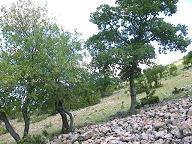Archaeobotany
Amanda KennedyWe reached the bottom of the mound in the south area and recovered a rich assemblage of charred and mineralised remains. The lower levels were quite wet, so there were probably never any waterlogged remains in this part of the mound. Some unique and productive contexts were excavated here, including stabling and lime burning deposits with evidence for the use of dung as fuel. However, as local irrigation schemes pose a threat to the stability of the water table and in turn the preservation of charred remains, our future aims must ensure stabilisation of the watertable so that the charred plant record in these unique deposits is not compromised.
Building 3 of the BACH area was a Neolithic household busy with activity. Three floors excavated here this season revealed evidence of crop processing in the form of chaff and cereal remains, feasting and post-consumption discard, a child burial with a cache of hackberries inside (possibly an offering) and a myriad of fire pits for cooking food, smoking and cleansing, with wood and chaff used as fuel. Charred and mineralised plants were recovered in the KOPAL area. They included the same taxa as those found on-site, though the assemblage here was smaller and certainly not as well preserved. One of the more unique finds was a cache of mineralised awns providing our first piece of good evidence for Neolithic cereal processing off-site. A find of molluscs and algae remains suggested that there was also a wet area here or nearby in the Neolithic.
The inhabitants of Çatalhöyük had a keen understanding of the products to be had from backswamp surrounding the site and those from the lands of others in the forested mountains at the edge of the Konya basin. The knowledge of these products including cereals, pulses, sea club-rushes, flax, hackberries, figs and wood, was used to build homes, fuel ovens, feed a community and craft baskets, boxes and bowls. Collaboration with the site illustrator helped us to set-up a lab display for the public, incorporating reconstruction drawings of possible Neolithic environments. Field trips to Kara Dağ to collect wild einkorn and visit remnant wetlands, and to the Taurus mountains to study coniferous forests helped to inform these drawings, as did a visit to the seed reference collection at the BIAA. |
 Figure 23: Oak and Hackberry growing on the slopes of Kara Dağ |
Ethnobotanical excursions to the local village of Küçükköy also kept us thinking about ways in which plants can be utilised and enjoyed. Cakes, made from pounded and cooked sea club-rush tubers, were even fed to unsuspecting diggers by our ethnobotany team! Excess energy was used to weed the flower and veggie patch, providing a place to retreat after hours and extra ingredients for the kitchen. The possibility of growing ancient emmer wheat and fruit trees next season will not only beautify the place, but will also create a living reference collection for visitors to view the kinds of plants that formed the Neolithic landscape.